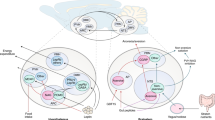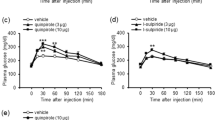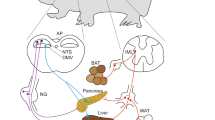Abstract
Glucose is the principal energy substrate for the brain and studies have shown that the brain is able to increase glucose availability in the face of glucose starvation (neurogly-copaenia)1–3. The mechanisms, believed to be hypothalamic3, that may be involved in a brain/blood glucose control system have not yet been identified. We have used novel techniques for assessing brain monoamine neuronal activity to investigate its relationship to blood glucose concentrations in the rat. We describe here two important relationships which emerge from these studies. One is that activation of hypothalamic noradrena-line (NA) activity following stress is associated with concurrent increases in plasma glucose concentrations. This relationship is linear and independent of the adrenal or pituitary glands. The second is an inverse relationship between plasma glucose con centration and hypothalamic NA neuronal activity—high blood glucose levels significantly inhibited the hypothalamic NA activity responses to stress, α2-adrenergic blockade and adrenalectomy. Thus glucose (or a metabolite of it) seems to provide a negative feedback signal sensed by hypothalamic NA neuronal systems which, in turn, appear to stimulate liver glucose output by a neural mechanism.
This is a preview of subscription content, access via your institution
Access options
Subscribe to this journal
Receive 51 print issues and online access
$199.00 per year
only $3.90 per issue
Buy this article
- Purchase on SpringerLink
- Instant access to full article PDF
Prices may be subject to local taxes which are calculated during checkout
Similar content being viewed by others
References
Brown, J. Metabolism 11, 1098–1112 (1962).
Korec, R. in Experimental Diabetes Mellitus in the Rat (ed. Korec, R.) 83–87 (Slovac Academy of Sciences, Bratislava, 1967).
Benzo, C. A. Life Sci. 32, 2509–2515 (1983).
Smythe, G. A., Bradshaw, J. E. & Vining, R. F. Endocrinology 113, 1062–1071 (1983).
Smythe, G. A., Duncan, M. W., Bradshaw, J. E. & Cai, W. Y. Endocrinology 110, 376–383 (1982).
Smythe, G. A., Bradshaw, J. E., Cai, W. Y. & Symons, R. G. Endocrinology 111, 1181–1191 (1982).
Feldman, M., Kiser, R. S., Unger, R. H. & Li, C. H. New Engl. J. Med. 308, 349–353 (1983).
Warsh, J. J., Li, P. P., Godse, D. D. & Chang, S. Life Sci. 29, 1303–1307 (1981).
Anden, N. E., Pauksens, K. & Svensson, K. J. Neural Transm. 55, 111–120 (1982).
Shimazu, T. Diabetologia Suppl. 20, 343–356 (1981).
Author information
Authors and Affiliations
Rights and permissions
About this article
Cite this article
Smythe, G., Grunstein, H., Bradshaw, J. et al. Relationships between brain noradrenergic activity and blood glucose. Nature 308, 65–67 (1984). https://doi.org/10.1038/308065a0
Received:
Accepted:
Issue Date:
DOI: https://doi.org/10.1038/308065a0
This article is cited by
-
Effects of pharmacological doses of 2-deoxyglucose on plasma catecholamines and glucose levels in patients with schizophrenia
Psychopharmacology (2004)
-
Differential activation of sympathetic nervous system and release of catecholamines during neuroglycopenia in awake rats
Bulletin of Experimental Biology and Medicine (1997)
-
Changes in Brain Monoaminergic Neurotransmitter Concentrations in Rat after Intracerebroventricular Injection of Streptozotocin
Journal of Cerebral Blood Flow & Metabolism (1992)
-
A microdialysis investigation of the release of norepinephrine in the hypothalamus induced by 2-deoxyglucose in awake rats
Neuroscience and Behavioral Physiology (1992)
-
The effects of sympathetic nervous system activation and psychological stress on glucose metabolism and blood pressure in subjects with Type 2 (non-insulin-dependent) diabetes mellitus
Diabetologia (1992)
Comments
By submitting a comment you agree to abide by our Terms and Community Guidelines. If you find something abusive or that does not comply with our terms or guidelines please flag it as inappropriate.



